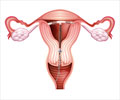Research suggests oral contraceptives may influence fear-related brain areas in women, shedding light on potential impacts.
- Current use of combined oral contraceptives (COCs) is associated with reduced thickness in the ventromedial prefrontal cortex, impacting emotion regulation
- Understanding the effects of sex hormones on brain development is crucial in light of widespread COC use
- While reversible after discontinuation, more studies are needed to fully comprehend the long-term impacts of COC use on brain anatomy
Influence of combined oral contraceptives on polycystic ovarian morphology-related parameters in Korean women with polycystic ovary syndrome
Go to source). A research team in Canada delved into both the immediate and enduring impacts of COC usage, as well as the influence of naturally produced and synthetic sex hormones on brain regions associated with fear processing, forming the neural pathway responsible for fear perception.
Lead researcher Alexandra Brouillard, from Université du Québec à Montréal, highlighted the findings, stating, "Our study demonstrates that women using COCs have a thinner ventromedial prefrontal cortex compared to men. This region is believed to support emotion regulation, including reducing fear signals in safe environments. This result may explain how COCs might affect emotion regulation in women."
Emotion Regulation and Contraceptive Use
Brouillard emphasized that when prescribing COCs, medical professionals often discuss physical side effects, such as the cessation of menstrual cycles and ovulation. However, the impact of sex hormones on ongoing brain development, which extends into early adulthood, is seldom addressed. Given the widespread use of COCs, understanding their current and long-term effects on brain structure and emotional regulation is crucial.The research team recruited women currently using COCs, those who had used them in the past but were not at the time of the study, women who had never used hormonal contraception, and men. This comparison allowed them to assess if COC usage correlated with current or lasting morphological changes and to identify any gender-based disparities, considering women's higher susceptibility to anxiety and stress-related conditions.
Changes in the Brain Structure due to the use of Contraceptives
"As we observed a reduction in cortical thickness of the ventromedial prefrontal cortex in COC users compared to men, our findings suggest that COCs may pose a risk for emotion regulation difficulties during their current usage," Brouillard explained.However, the effects of COC use may be reversible after discontinuation. The vmPFC thinning observed in current users was not present in past users, indicating potential reversibility. The researchers noted that further studies are required to confirm these observations.
There is still much to uncover about how COC usage impacts women's brains. Brouillard and her team are currently investigating the influence of age of onset and duration of use to gain deeper insights into potential lasting effects. Considering that many teenage girls initiate COC use during adolescence, a crucial period in brain development, age at initiation may also influence reversibility.
The researchers acknowledge limitations in their study, cautioning against implying a causal relationship between COC use and brain morphology, as well as urging caution when generalizing results to the broader population. They also emphasized that drawing conclusions about behavioral and psychological impacts from anatomical findings is premature at this stage.
Reference:
- Influence of combined oral contraceptives on polycystic ovarian morphology-related parameters in Korean women with polycystic ovary syndrome - (https://www.ncbi.nlm.nih.gov/pmc/articles/PMC6962579/)















